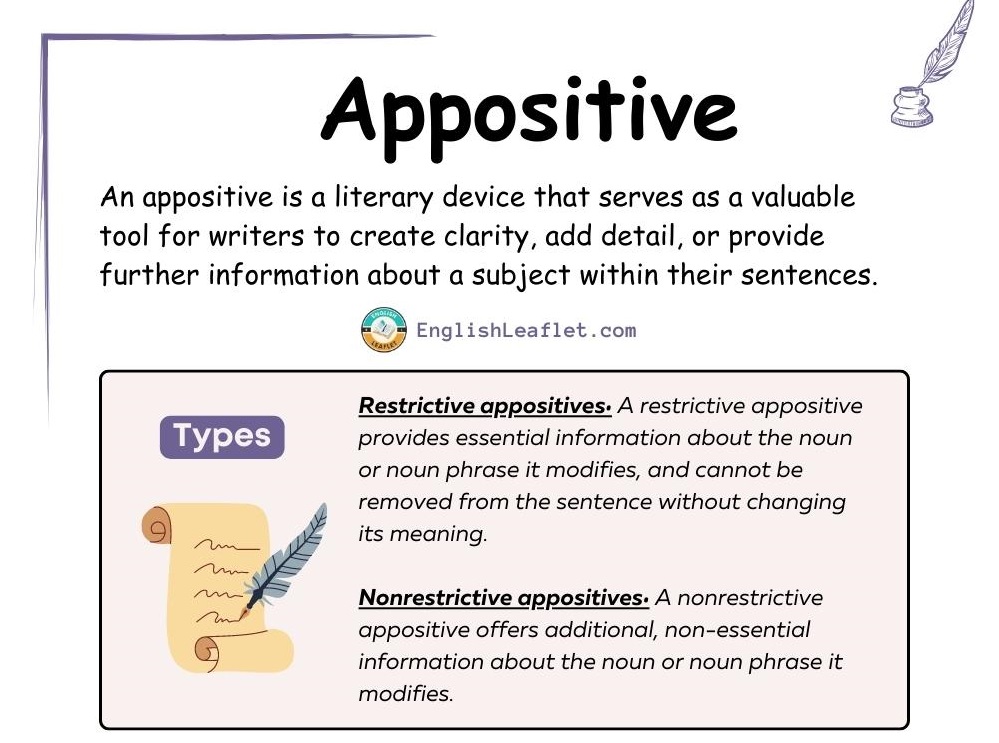An appositive is a literary device that serves as a valuable tool for writers to create clarity, add detail, or provide further information about a subject within their sentences. This grammatical construction consists of a noun or noun phrase that renames, identifies, or explains another noun or noun phrase placed beside it. In this article, we will delve into the concept of appositives, their functions, different types, and examples of appositives in literature and everyday language.
What is an Appositive?
In grammar, an appositive is a noun, pronoun, or noun phrase that sits next to another noun or noun phrase to provide additional information or clarify its meaning. Appositives can be found in both fiction and nonfiction writing, and they serve various purposes, including adding detail, providing examples, or simply offering a clearer explanation of a concept or idea. Appositives are set off by commas, parentheses, or dashes, depending on the writer’s preference and the emphasis they wish to place on the additional information.
Functions of Appositives
- Clarification: Appositives can help clarify the meaning of a noun or noun phrase by providing additional information or a more specific identification. This can be particularly useful when discussing complex subjects, introducing new concepts, or providing context for an unfamiliar term.
- Detail: By adding more information about a subject, appositives can make a sentence more vivid, descriptive, and engaging. This can be especially useful in fiction writing, where authors strive to create compelling characters and vivid settings to captivate their readers.
- Emphasis: Appositives can also be used to emphasize a particular aspect of a subject, drawing the reader’s attention to a specific detail or characteristic. This can be helpful in creating a specific tone or mood, or simply highlighting an important piece of information.
- Variety: Appositives allow writers to introduce variety into their sentence structures, making their writing more dynamic and engaging. By incorporating appositives, authors can avoid monotonous or repetitive sentence patterns, which can be tiresome for readers.
Types of Appositives
There are two primary types of appositives:
- Restrictive appositives: A restrictive appositive provides essential information about the noun or noun phrase it modifies, and cannot be removed from the sentence without changing its meaning. Restrictive appositives are not set off by commas, as the information they provide is considered necessary for understanding the sentence.
- Nonrestrictive appositives: A nonrestrictive appositive offers additional, non-essential information about the noun or noun phrase it modifies. Because this information is not necessary for understanding the sentence, nonrestrictive appositives are set off by commas, parentheses, or dashes. Removing a nonrestrictive appositive from the sentence will not change its overall meaning, although some detail may be lost.
Examples of Appositives in Literature
- “The Great Gatsby” by F. Scott Fitzgerald:
“My friend, the football player, came to visit me.”
In this example, “the football player” is a nonrestrictive appositive that provides additional information about the noun “my friend.” The sentence would still make sense without the appositive, but it adds detail and specificity to the description.
- “To Kill a Mockingbird” by Harper Lee:
“We were far too old to settle an argument with a fist-fight, so we consulted Atticus, our father.”
In this example from “To Kill a Mockingbird,” the appositive “our father” provides clarification about the noun “Atticus.” It’s a nonrestrictive appositive, as the sentence would still be understandable without it, but the additional information helps to establish the relationship between the characters.
- “Moby-Dick” by Herman Melville:
“The dark ocean, an endless expanse of water, lay before him.”
Here, “an endless expanse of water” is a nonrestrictive appositive that adds detail to the noun phrase “the dark ocean.” Although the sentence would still make sense without the appositive, it enhances the imagery and atmosphere of the scene.
- “Pride and Prejudice” by Jane Austen:
“Her sister, Elizabeth, was the clever one.”
In this example, “Elizabeth” is a restrictive appositive that identifies the specific sister being referred to as the clever one. Removing the appositive would make the sentence less clear, as the reader would not know which sister is being discussed.
Examples of Appositives in Everyday Language
- “My car, a red convertible, needs a new battery.”
In this sentence, “a red convertible” is a nonrestrictive appositive that adds detail to the noun “my car.” The sentence would still make sense without the appositive, but it provides the reader with a more vivid description.
- “The CEO of the company, John Smith, announced his resignation.”
Here, “John Smith” is a nonrestrictive appositive that identifies the specific individual who is the CEO of the company. While the sentence would still be understandable without the appositive, it offers clarity and helps the reader to connect the action to a specific person.
- “Her favorite book, ‘To Kill a Mockingbird,’ is a classic.”
In this example, “‘To Kill a Mockingbird'” is a restrictive appositive that provides essential information about the noun “her favorite book.” Without the appositive, the sentence would be unclear, as the reader would not know which book is being referred to as her favorite.
Tips for Using Appositives
- Punctuation: Be mindful of punctuation when using appositives. Nonrestrictive appositives should be set off by commas, parentheses, or dashes, while restrictive appositives do not require any additional punctuation.
- Clarity: Use appositives to improve the clarity of your writing. If a sentence is unclear or requires additional information, consider incorporating an appositive to provide the necessary context or detail.
- Variety: Remember that appositives can help add variety to your sentence structures. By incorporating appositives into your writing, you can create more engaging and dynamic prose that holds the reader’s interest.

More to read

